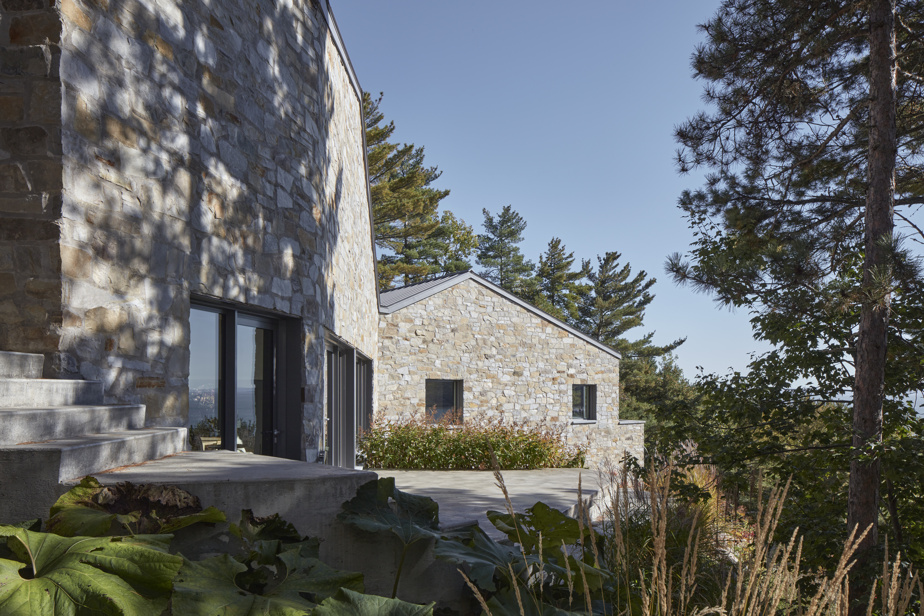Enchanted by cliffside land in the Charlevoix region, a family took up the challenge of building a house there without cutting down a single tree. The Atelier Carle has imagined a habitat for her guided by a route on six plateaus. An approach on the edge of architecture and artistic performance.
From the top of this rocky cape facing Baie-Saint-Paul, the sparkling river on the horizon attracts the eye. This point of view immediately won the heart of Julie, who happily contemplates the ballet of the tides every day. “At low tide, we can sometimes walk to Baie-Saint-Paul,” she says.
The vertiginous slope, the granite soil and the seismic activity under close surveillance in the Charlevoix region did not dampen his enthusiasm. Ditto for the municipal ban on cutting trees in the forest where his house would take root. For this extraordinary project, she turned to Atelier Carle, which has several residences in the surrounding area in its portfolio.

PHOTO JAMES BRITTAIN, PROVIDED BY ATELIER CARLE
Unsuspected from the street, the house can be discovered from a small entrance on the left. The other wing houses a garage and a guest studio.
The architect Alain Carle relegates formal considerations to the background to focus on the very particular nature of the land. He imagines an architecture following a predefined path on the ground. “It was an almost corporeal logic, a physical relationship to the territory,” observes the founder of Atelier Carle.
Life in this steep space is envisaged diagonally by means of six floors connected by stairs leading to terraces.
The whole project has been designed so as to insert a course in the cliff along the building. We wanted to have as much as possible the impression that we had a flat ground at the edge of the house.
The architect Alain Carle
-

PHOTO JAMES BRITTAIN, PROVIDED BY ATELIER CARLE
A staircase leads from the mezzanine entrance to the living room and the lounge a few steps lower.
-

PHOTO JAMES BRITTAIN, PROVIDED BY ATELIER CARLE
The house has four fireplaces. The family likes to gather in front of the one in the living room.
-

PHOTO JAMES BRITTAIN, PROVIDED BY ATELIER CARLE
The fireplace installed on the terrace on the living room side is used even on cool days, because the cliff protects it from the wind.
1/3
Highlands
To give shape to the Capo project, echoing its direction, Atelier Carle does not hesitate to shake up traditional domestic codes. A maze of stairs and secret passages punctuate the interior life. The configuration and orientation of the rooms offer views of the surrounding nature, from the majestic river to the discreet undergrowth.
-

PHOTO JAMES BRITTAIN, PROVIDED BY ATELIER CARLE
The living room has a triple height ceiling. The staircase leads to the entrance of the house.
-

PHOTO JAMES BRITTAIN, PROVIDED BY ATELIER CARLE
Corner windows offer another view of the forest that borders the house.
-

PHOTO JAMES BRITTAIN, PROVIDED BY ATELIER CARLE
The floor of the master bedroom has been raised to prevent the balcony railing from obstructing the view of the river.
-

PHOTO JAMES BRITTAIN, PROVIDED BY ATELIER CARLE
The wooden doors in the couple’s bathroom have no handles so as not to catch the eye
-

PHOTO JAMES BRITTAIN, PROVIDED BY ATELIER CARLE
The master bathroom, directly overlooking the cliff, makes any blind superfluous.
1/5
The house is accessed via a narrow mezzanine space opening onto a large living room. The family has been experimenting with a new way of life there for four years. Every day, she uses a wood-fired oven in the kitchen area to cook bread, pizzas or meat bought from local producers. “I didn’t want traditional cuisine. It’s festive when we receive in the evening. Everyone gathers around the oven,” says Julie, who occasionally hosts her daughter Anne-Sophie’s hockey team, whose bedroom, three floors below, has been converted into a dormitory.
Glass doors in the living room lead to a terrace sheltered from the wind on the forest side where a fireplace warms the air as needed. “It was important to create outdoor spaces that could be appropriated,” points out Alain Carle. Thanks to a smooth transition between the different levels of the house, only the couple’s bedroom balcony has been fitted with a railing. The room’s smooth concrete floor has been raised slightly so that the gaze can wander freely over the horizon. Below, gardens, jacuzzi and terraces follow one another.
The surface of the septic tank, near the river, even accommodates a petanque court. “It’s a place we like to enjoy with friends and neighbours. The land is perfectly oriented. At 4 p.m., for the aperitif, the sun is there,” says Julie.

PHOTO JAMES BRITTAIN, PROVIDED BY ATELIER CARLE
Several windows in the house frame views like paintings.
Block
In view of the many challenges that accompanied this project, the owner chose to manage the construction site herself. She even put her hand to work, pouring the concrete, installing the heating system and even the wooden panels for the walls and stairs.
The house, built directly on the rock using insulating formwork and chemical anchoring, follows the topography of the cape to ensure better resistance in the event of an earthquake. If the site was sometimes perilous because of the configuration of the land and the respect given to the trees present on it, Julie does not regret her decision. “I wanted to build our house. This work has contributed to the pleasure of living there,” she underlines.
